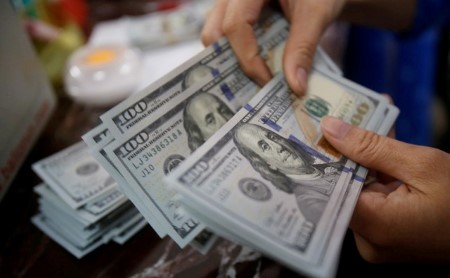




Quarterly Economic Growth Release: More BSP cuts to come
 DOWNLOAD
DOWNLOAD

Monthly Economic Update: Fed catches up
 DOWNLOAD
DOWNLOAD

Inflation Update: Steady and mellow
 DOWNLOAD
DOWNLOAD


Japan’s yen climbs against US dollar amid signs of intervention

NEW YORK – The yen soared against the US dollar late on Wednesday, as market participants suspected Japan’s monetary authorities were in the market to prop up the beleaguered currency.
The Japanese unit rose as high as 153.19 per dollar from about 157.55. It was last at 154.83.
Market participants said the move happened right after the US stock market close and after Fed Chair Jerome Powell wrapped up his press briefing.
“It looks like intervention. The Japanese, I don’t think, are going to say anything or admit to it. They didn’t the last time, but it certainly looks like it,” said Joe Trevisani, senior analyst at FX Street.
The yen also jumped on Monday to 154 after hitting a 34-year low of 160.245 per dollar. Japanese officials on Monday declined to comment.
But Bank of Japan data showed that the Japanese central bank, which acts on behalf of the Ministry of Finance, may have spent some 5.5 trillion yen (USD 35.06 billion) supporting the currency on Monday.
The yen has been under pressure as US interest rates have climbed and Japan’s have stayed near zero, driving cash out of yen and into dollars to earn so-called “carry”.
The US dollar, meanwhile, fell on Wednesday after the Fed signaled it is still leaning toward eventual reductions in borrowing costs, but repeated that it wants to gain “greater confidence” that inflation will continue to fall before cutting rates.
“In recent months, there has been a lack of further progress towards the Committee’s 2% inflation objective,” the Fed said in its statement.
The statement was largely as expected while Powell also said at a press conference that it is unlikely that the US central bank’s next move will be a hike, easing some concerns about the Fed potentially pivoting to a more hawkish stance.
Stickier-than-expected consumer price inflation in March dashed hopes that elevated readings in January and February were anomalies, leading traders to push back expectations on when the US central bank is likely to cut interest rates.
Fed fund futures traders are now pricing in 35 basis points of easing this year, up from 29 basis points before the Fed statement.
“The lack of change in forward guidance was marginally dovish, and I am not sure the new inserted phrase about lack of progress on inflation is enough to offset that,” said John Velis, FX and macro strategist at BNY Mellon in New York.
In late trading, the dollar index fell 0.6% to 105.69 after earlier reaching 106.49, the highest since April 16. A break above 106.51 would be the highest since early November.
The Fed also announced it will scale back the pace at which it is shrinking its balance sheet starting on June 1, allowing only USD 25 billion in Treasury bonds to run off each month versus the current USD 60 billion. Mortgage-backed securities will continue to run off by up to USD 35 billion monthly.
The next major economic indicator will be Friday’s jobs report for April, which is expected to show that employers added 243,000 jobs during the month.
The ADP Employment report on Wednesday showed that US private payrolls increased more than expected in April while data for the prior month was revised higher.
A US Labor Department report on Wednesday, meanwhile, showed that US job openings fell to a three-year low in March, while the number of people quitting their jobs declined.
The euro was last flat at USD 1.0711. The pound was also little changed at USD 1.2525.
In cryptocurrencies, bitcoin rose 0.8% to USD 57,708, after earlier reaching USD 56,483, the lowest since Feb. 27.
(Reporting by Gertrude Chavez-Dreyfuss, Karen Brettell, and Caroline Valetkevitch; Additional reporting by Laura Matthews and Chibuike Oguh in New York; editing by Barbara Lewis, Will Dunham, and Cynthia Osterman)
This article originally appeared on reuters.com





 By Reuters
By Reuters